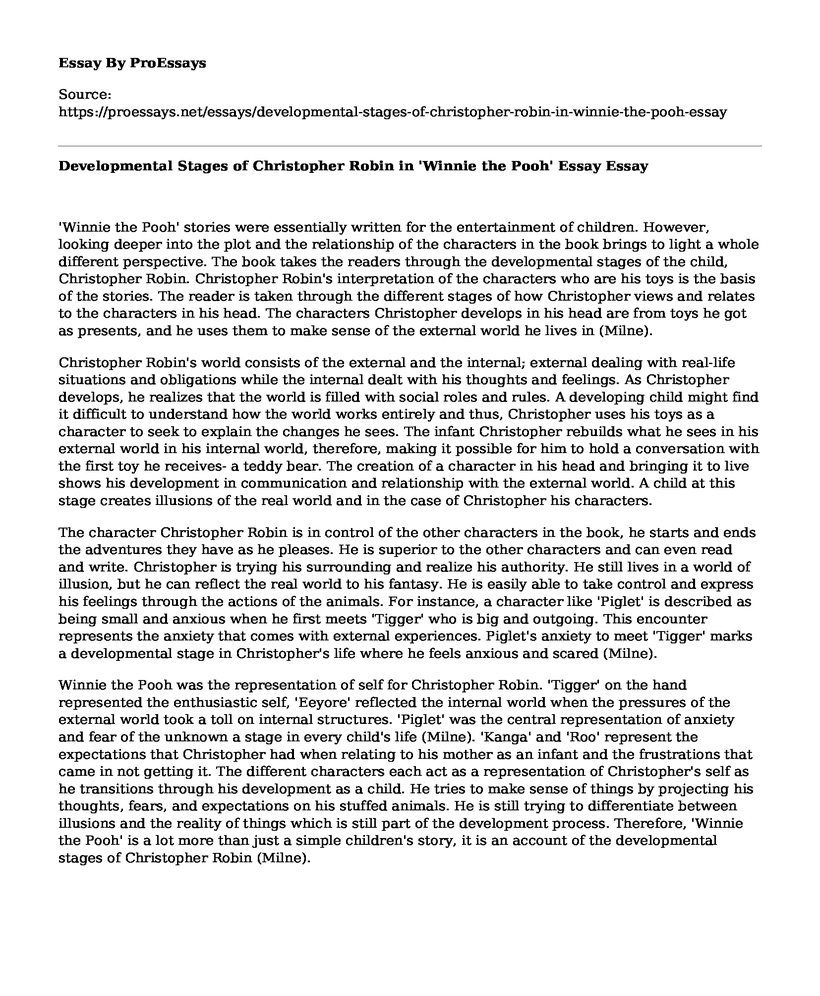'Winnie the Pooh' stories were essentially written for the entertainment of children. However, looking deeper into the plot and the relationship of the characters in the book brings to light a whole different perspective. The book takes the readers through the developmental stages of the child, Christopher Robin. Christopher Robin's interpretation of the characters who are his toys is the basis of the stories. The reader is taken through the different stages of how Christopher views and relates to the characters in his head. The characters Christopher develops in his head are from toys he got as presents, and he uses them to make sense of the external world he lives in (Milne).
Christopher Robin's world consists of the external and the internal; external dealing with real-life situations and obligations while the internal dealt with his thoughts and feelings. As Christopher develops, he realizes that the world is filled with social roles and rules. A developing child might find it difficult to understand how the world works entirely and thus, Christopher uses his toys as a character to seek to explain the changes he sees. The infant Christopher rebuilds what he sees in his external world in his internal world, therefore, making it possible for him to hold a conversation with the first toy he receives- a teddy bear. The creation of a character in his head and bringing it to live shows his development in communication and relationship with the external world. A child at this stage creates illusions of the real world and in the case of Christopher his characters.
The character Christopher Robin is in control of the other characters in the book, he starts and ends the adventures they have as he pleases. He is superior to the other characters and can even read and write. Christopher is trying his surrounding and realize his authority. He still lives in a world of illusion, but he can reflect the real world to his fantasy. He is easily able to take control and express his feelings through the actions of the animals. For instance, a character like 'Piglet' is described as being small and anxious when he first meets 'Tigger' who is big and outgoing. This encounter represents the anxiety that comes with external experiences. Piglet's anxiety to meet 'Tigger' marks a developmental stage in Christopher's life where he feels anxious and scared (Milne).
Winnie the Pooh was the representation of self for Christopher Robin. 'Tigger' on the hand represented the enthusiastic self, 'Eeyore' reflected the internal world when the pressures of the external world took a toll on internal structures. 'Piglet' was the central representation of anxiety and fear of the unknown a stage in every child's life (Milne). 'Kanga' and 'Roo' represent the expectations that Christopher had when relating to his mother as an infant and the frustrations that came in not getting it. The different characters each act as a representation of Christopher's self as he transitions through his development as a child. He tries to make sense of things by projecting his thoughts, fears, and expectations on his stuffed animals. He is still trying to differentiate between illusions and the reality of things which is still part of the development process. Therefore, 'Winnie the Pooh' is a lot more than just a simple children's story, it is an account of the developmental stages of Christopher Robin (Milne).
Work Cited
Milne, Alan Alexander, and Ernest Howard Shepard. The world of Pooh: The complete Winnie-the-Pooh and the house at Pooh Corner. Dutton, 1957.
Cite this page
Developmental Stages of Christopher Robin in 'Winnie the Pooh' Essay. (2022, Nov 20). Retrieved from https://proessays.net/essays/developmental-stages-of-christopher-robin-in-winnie-the-pooh-essay
If you are the original author of this essay and no longer wish to have it published on the ProEssays website, please click below to request its removal:
- Creativity and Rationality in Charlotte Gilman's The Yellow Wallpaper
- Comparison of Dante's "Divine Comedy" and Chaucer's "Canterbury Tales"
- Change, Alienation, and Isolation in "The Metamorphosis" by Franz Kafka Essay
- Critical Essay Sample on To Kill a Mockingbird
- Sylvia Plath: The Fearful - Literary Analysis Essay
- Essay Example on The Human Stain: Identity, Change, and Freedom
- Essay Example on A Comparative Analysis of 'Hills like White Elephants' and 'Good People'







